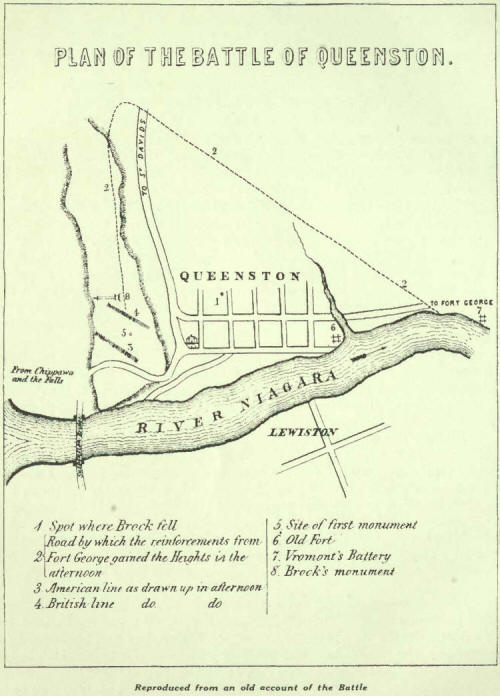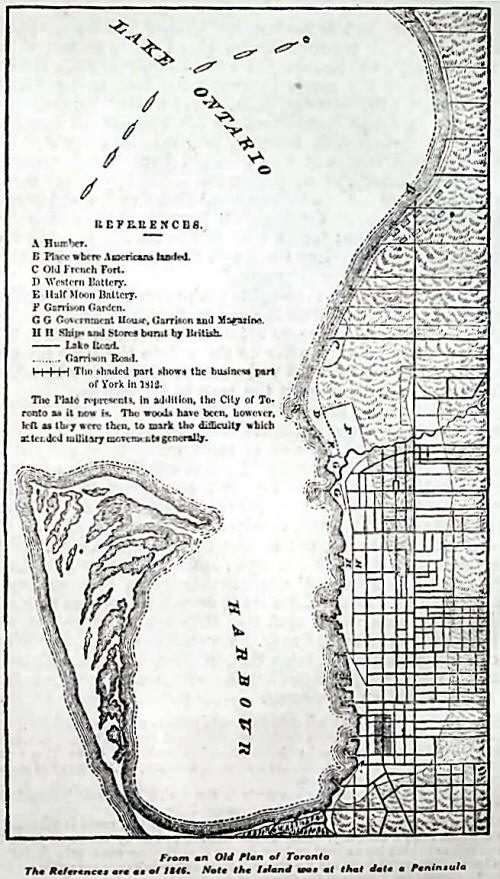|
Push on the York
Volunteers
THIS is not the attempt
to re-tell the battle of Queenston Heights, which has often been written
with enthusiasm, yea and even with eloquence and occasionally with
accuracy. It is merely to tell why as his last order Brock saw fit to
push on the York Volunteers.
Well on the morning of October 13th, 1812, a miniature British army was
defending a frontier of some thirty-six miles from Fort Erie to
Niagara-on-the-Lake, its commander, General Isaac Brock, being obliged
by his instructions from Sir George Prevost to adopt purely defensive
measures. In a letter of September 18th, Brock had written his brother
Savory: “You will hear of some decided action in the course of a
fortnight or in all probability we shall return to a state of
tranquility. I say decisive because if 1 should be beaten the province
is inevitably gone; and should I be victorious, I do not imagine the
gentry from the other side will care to return to the charge.”
He lay in some, force at Fort George, which he had equipped to silence
the American Fort Niagara, expecting that the movement of invasion would
be around his left flank, while Fort Niagara would effect a diversion
with its guns.
The seven miles of river from Fort George to Queenston he had picketed
with what history has dignified as batteries. Thus at the Heights about
half-way down the hill was the Redan Battery (armed with an eighteen
pounder) with Capt. Williams' flank company of the Green Tigers (the
49th Regiment). In the village of Queenston was the other flank company
under Major Dennis, along with Chisholm and Hatt's Militia Companies and
a brass six pounder and two three pounders handled by a small detachment
of artillery. Of the Yorks, Howard's Company, under Lieut. Robinson and
Cameron’s Company were stationed at Brown’s Point two miles below
Queenston. At night Robinson acted as an extra guard to the Battery at
Vroonian’s Point nearer Queenston and returned in the morning to the
command of his senior, Capt. Cameron, at Brown’s Point.
General Van Rensselaer did not attack Fort George, probably for the
reason that he felt he w«m expected there. But, merely demonstrating in
that quarter, he secretly concentrated at Fort Gray opposite Queenston
and proceeded to drive a wedge through the centre of the thinly held
line of British. Ilis boats were received on the Canadian shore with a
vigour that surprised them; some being sunk and those who landed getting
it hot and dry from musket and bayonet; the survivors being sent under
escort to Fort George. The guns in Fort Gray and the Redan on Queenston
kept up a furious cannonade that sent the news down the River to Cameron
and Brock.

Capt. Cameron was not a
professional soldier and was not instructed for this emergency. But with
a correct instinct he decided to march to the sound of the guns and put
his two companies of York Volunteers upon the road towards Queenston. On
their way a single horseman overtook and passed them at a gallop, waving
his hand to them and urging them as Robinson writes: “to follow with
expedition.” This was Isaac Brock on his way to his last battle. Soon
after, that darling of Canadian soldiery, Col. Macdonell galloped by,
also to meet his fate; and with him rode Capt. Glegg, Brock’s other
aide-de-camp.
It is a matter of history, fittingly commemorated by the tall monument
that towers above the heights he strove to regain,1 that Brock met his
end as he had won his victories by attempting the desperate to ward off
the seemingly inevitable. Nor was the attempt in vain; for the fury of
the contest and the boat loads of wounded returning to the American
shore had that moral effect on the adversary, Which decided the victory
of the afternoon.
Twice Brock strove to gain the heights with every soldier he could spare
from Queenston and twice he failed. But the words, “Push on the York
Volunteers,” whether spoken by him just before or after he was struck
were not heroics nor melodrama but a plain military order to throw into
the issue his one available reserve, namely, the two companies under
Capt. Cameron which following the trail of their general were panting up
the road to Queenston.
Col. Macdonell rode to his death on the left flank of the York
Volunteers and when he fell mortally wounded Capt. Cameron carried him
off amid a shower of musketry. The shattered remains of these much tried
pickets were rallied about a mile below the heights and marching through
the fields back of Queenston joined themselves to the centre of
Sheaffe’s advancing column. Nor did the gruelling punishment of the
morning prevent their earning their place in that famous dispatch of
General Sheaffe, in which he says:
“Lieut-Cols. Butler and Clark of the militia; and Capts. Hatt, Durand,
Howe, Applegarth, James Crooks, Cooper, Robert Hamilton, McEwen, Duncan
Cameron, and Lieuts. Richardsons and Thomas Butler, commanding flank
companies of the Lincoln and York militia led their men into action with
great spirit.''
The great spirit with which that day they led on their men and General
Sheaffe led his, was that of Isaac Brock. e shall see that this spirit
evaporated from some of the generals if not from their juniors, and that
soldiers who under Brock’s influence were intrepid, like Sheaffe and
Proctor, became soon afterwards vacillating, disheartened and timorous.
 |
